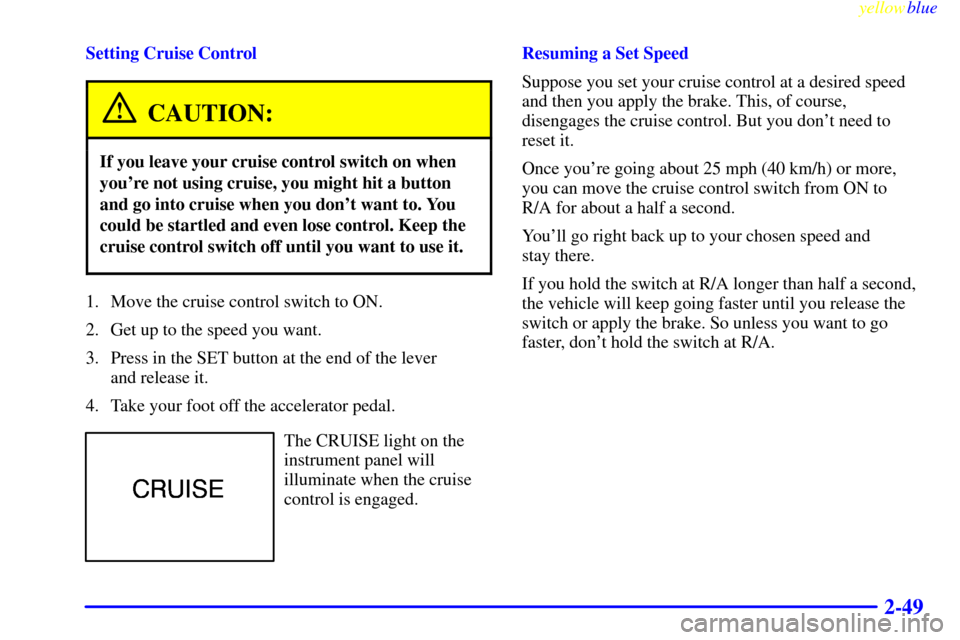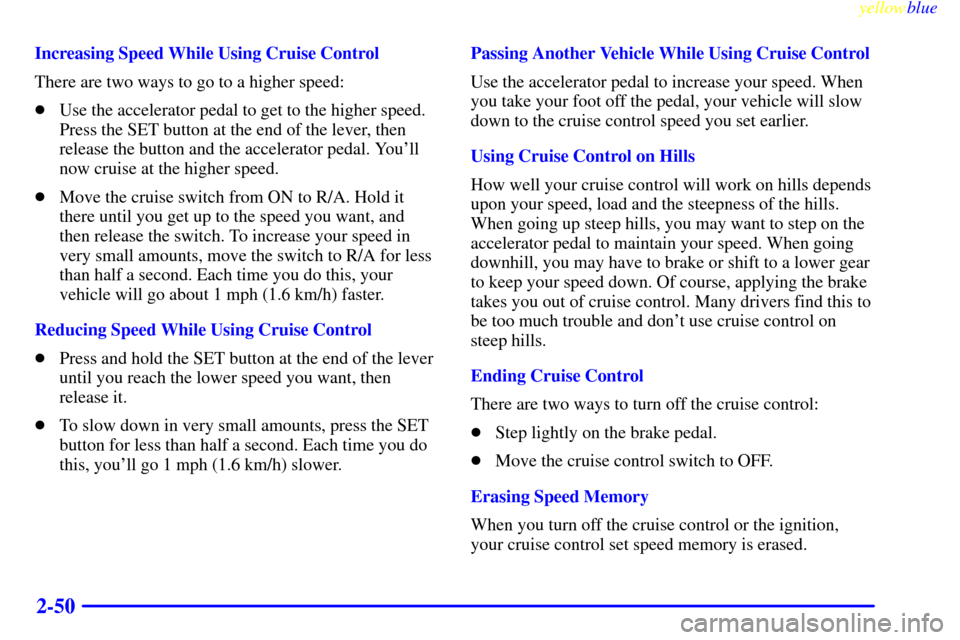Page 116 of 432
yellowblue
2-44
Tilt Wheel (If Equipped)
The tilt steering wheel
allows you to adjust the
steering wheel before
you drive.
You can also raise it to the highest level to give your
legs more room when you enter and exit the vehicle.
To tilt the wheel, hold the steering wheel and pull the
lever. Move the steering wheel to a comfortable level,
then release the lever to lock the wheel in place.
Turn Signal/Multifunction Lever
The lever on the left side of the steering column
includes your:
�Turn Signal and Lane Change Indicator
�Headlamp High/Low Beam Changer
�Flash
-to-Pass
�Windshield Wipers
�Windshield Washer
�Cruise Control (If Equipped)
Page 120 of 432
yellowblue
2-48 Cruise Control
With cruise control, you can
maintain a speed of about
25 mph (40 km/h) or more
without keeping your foot
on the accelerator. This can
really help on long trips.
Cruise control does not
work at speeds below about
25 mph (40 km/h).
If you apply your brakes, the cruise control
will disengage.CAUTION:
�Cruise control can be dangerous where you
can't drive safely at a steady speed. So,
don't use your cruise control on winding
roads or in heavy traffic.
�Cruise control can be dangerous on
slippery roads. On such roads, fast changes
in tire traction can cause needless wheel
spinning, and you could lose control. Don't
use cruise control on slippery roads.
Page 121 of 432

yellowblue
2-49
Setting Cruise Control
CAUTION:
If you leave your cruise control switch on when
you're not using cruise, you might hit a button
and go into cruise when you don't want to. You
could be startled and even lose control. Keep the
cruise control switch off until you want to use it.
1. Move the cruise control switch to ON.
2. Get up to the speed you want.
3. Press in the SET button at the end of the lever
and release it.
4. Take your foot off the accelerator pedal.
The CRUISE light on the
instrument panel will
illuminate when the cruise
control is engaged.Resuming a Set Speed
Suppose you set your cruise control at a desired speed
and then you apply the brake. This, of course,
disengages the cruise control. But you don't need to
reset it.
Once you're going about 25 mph (40 km/h) or more,
you can move the cruise control switch from ON to
R/A for about a half a second.
You'll go right back up to your chosen speed and
stay there.
If you hold the switch at R/A longer than half a second,
the vehicle will keep going faster until you release the
switch or apply the brake. So unless you want to go
faster, don't hold the switch at R/A.
Page 122 of 432

yellowblue
2-50
Increasing Speed While Using Cruise Control
There are two ways to go to a higher speed:
�Use the accelerator pedal to get to the higher speed.
Press the SET button at the end of the lever, then
release the button and the accelerator pedal. You'll
now cruise at the higher speed.
�Move the cruise switch from ON to R/A. Hold it
there until you get up to the speed you want, and
then release the switch. To increase your speed in
very small amounts, move the switch to R/A for less
than half a second. Each time you do this, your
vehicle will go about 1 mph (1.6 km/h) faster.
Reducing Speed While Using Cruise Control
�Press and hold the SET button at the end of the lever
until you reach the lower speed you want, then
release it.
�To slow down in very small amounts, press the SET
button for less than half a second. Each time you do
this, you'll go 1 mph (1.6 km/h) slower.Passing Another Vehicle While Using Cruise Control
Use the accelerator pedal to increase your speed. When
you take your foot off the pedal, your vehicle will slow
down to the cruise control speed you set earlier.
Using Cruise Control on Hills
How well your cruise control will work on hills depends
upon your speed, load and the steepness of the hills.
When going up steep hills, you may want to step on the
accelerator pedal to maintain your speed. When going
downhill, you may have to brake or shift to a lower gear
to keep your speed down. Of course, applying the brake
takes you out of cruise control. Many drivers find this to
be too much trouble and don't use cruise control on
steep hills.
Ending Cruise Control
There are two ways to turn off the cruise control:
�Step lightly on the brake pedal.
�Move the cruise control switch to OFF.
Erasing Speed Memory
When you turn off the cruise control or the ignition,
your cruise control set speed memory is erased.
Page 152 of 432
yellowblue
2-80
CAUTION:
Don't keep driving if the oil pressure is low.
If you do, your engine can become so hot that
it catches fire. You or others could be burned.
Check your oil as soon as possible and have your
vehicle serviced.
NOTICE:
Damage to your engine from neglected oil
problems can be costly and is not covered by
your warranty.
Cruise Light (If Equipped)
The CRUISE light comes
on whenever you set your
cruise control. See ªCruise
Controlº in the Index.
4WD Light (If Equipped)
The 4WD indicator will
light up when you shift a
manual transfer case into
four
-wheel drive and the
front axle engages.
Some delay between shifting and the indicator's lighting
is normal.
See ªFour
-Wheel Driveº in the Index for
more information.
Page 364 of 432
yellowblue
6-66
NAME Usage
L BODY Retained Accessory Power Relay
LOCK Power Door Locks
DRV UNLOCK Power Door Lock RelayNAME Usage
LOCK Power Door Lock Relay
HVAC 1 Climate Control System
CRUISE Cruise Control, Instrument Cluster
IGN 3 Ignition, Power Seats
4WD Four
-Wheel Drive System,
Auxiliary Battery
CRANK Starting System
INT PRK Parking Lamps, Sidemarker
Lamps, Interior Lamps
L DOOR Power Door Lock Relay
BRAKE Anti
-Lock Brake System
RR WIPER Not Used
ILLUM Interior Lamps
SEAT Power Seat Circuit Breaker
Page 369 of 432

yellowblue
6-71
Name Usage
STUD #1 Accessory Power/Trailer Wiring
Feed
ABS Anti
-Lock Brakes
IGN A Ignition Switch
AIR A.I.R. System
RAP #1 Retained Accessory Power, Power
Mirrors, Power Door Locks,
Power Seat(s)
IGN B Ignition Switch
RAP #2 Not Used
STUD #2 Accessory Power/Trailer Wiring
Brake Feed
TRL R TRN Right Turn Signal Trailer Wiring
TRL L TRN Left Turn Signal Trailer Wiring
IGN 1 Ignition, Fuel Controls
INJ B Ignition, Fuel Controls (Relay)
STARTER Starter (Relay)
PARK LP Parking Lamps
FRT HVAC Climate Control System
STOP LP Exterior Lamps, Stoplamps
ECM 1 VCM/PCM
CHMSL Center High Mounted Stoplamp
VEH STOP Stoplamps, Cruise ControlName Usage
TRL B/U Backup Lamps Trailer Wiring
INJ A Fuel Controls, Ignition
RR HVAC Not Used
VEH B/U Vehicle Backup Lamps
ENG 1 Engine Controls, Canister Purge,
Fuel System
ETC Electronic Throttle Control
IGN E A/C Compressor Relay, Rear
Window Defogger, Daytime
Running Lamps, A.I.R. System
B/U LP Backup Lamps, BTSI
ATC Automatic Transfer Case
RR DEFOG Rear Window Defogger, Heated
Mirrors (Relay)
RR PRK Right Rear Parking Lamps
ECM B VCM/PCM
F/PMP Fuel Pump (Relay)
O2 A Oxygen Sensors
O2 B Oxygen Sensors
LR PRK Left Rear Parking Lamps
RR DEFOG Rear Window Defogger, Heated
Mirrors
HDLP Headlamps (Relay)
Page 400 of 432

yellowblue
7-24 Throttle System Inspection
Inspect the throttle system for interference or binding,
and for damaged or missing parts. Replace parts as
needed. Replace any components that have high effort
or excessive wear. Do not lubricate accelerator and
cruise control cables.
Drive Axle Service
Check rear/front axle fluid level and add as needed.
Check constant velocity joints and axle seals for leaking.
Transfer Case (Four-Wheel Drive)
Inspection
Every 12 months or at oil change intervals, check front
axle and transfer case and add lubricant when necessary.
On manual shift transfer case, oil the control lever pivot
point. Check vent hose at transfer case for kinks and
proper installation. More frequent lubrication may be
required on off
-road use.
Brake System Inspection
Inspect the complete system. Inspect brake lines and
hoses for proper hook
-up, binding, leaks, cracks,
chafing, etc. Inspect disc brake pads for wear and rotors
for surface condition. Inspect other brake parts,
including calipers, parking brake, etc. You may need to
have your brakes inspected more often if your driving
habits or conditions result in frequent braking.